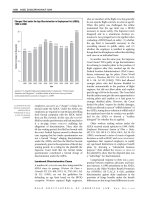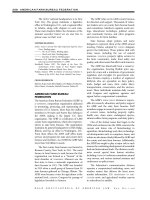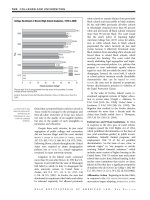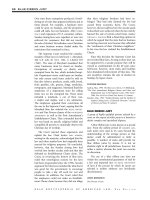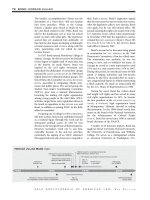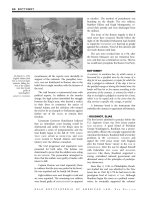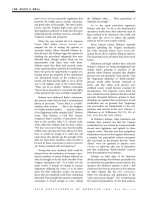Gale Encyclopedia Of American Law 3Rd Edition Volume 4 P57 pptx
Bạn đang xem bản rút gọn của tài liệu. Xem và tải ngay bản đầy đủ của tài liệu tại đây (195.43 KB, 6 trang )
to the organization’s exercise of its free speech
rights. Justice CLARENCE THOMAS, in his majority
opinion, addressed the freedom-of-speech ar-
gument. He noted that the school was a limited
public forum and that the state, therefore, was
not required to permit persons “to engage in
every type of speech.” However, the state’s
ability to restrict speech was not unlimited. In
addition, the state could not discriminate
against speech on the basis of viewpoint. Justice
Thomas wrote that the school district decision
had unlawfull y imposed this requirement. He
pointed to recent Court decisions that had
forbidden states to prevent religious groups
from using public facilities or to receive funding
for an undergraduate organization.
Statutes that prohibit the desecration of the
U.S.
FLAG have been found to restrict free
expression unconstitutionally. In Texas v.
Johnson, 491 U.S. 397, 109 S. Ct. 2533, 105 L.
Ed. 2d 342 (1989), the Court overturned
Gregory L. Johnson’s conviction for burning a
U.S. flag during a demonstration. Johnson’s
actions were communicative conduct that
warranted First Amendment protection, even
though they were repugnant to many people.
Similarly, in United States v. Eichman, 496 U.S.
310, 110 S. Ct. 2404, 110 L. Ed. 2d 287 (1990),
the Court struck down the federal Flag Protec-
tion Act of 1989, 103 Stat. 777, 18 U.S.C.A.
§ 700, stating that the government’s interest in
passing the act had been a desire to suppress
free expression and the content of the message
that the act of flag burning conveys.
The U.S. Supreme Court has generally
struck down prohibitions on nudity and other
erotic, but not obscene, expressive conduct.
However, in Barnes v. Glen Theatre, 501 U.S.
560, 111 S. Ct. 2456, 115 L. Ed. 2d 504 (1991),
the Court upheld a ban on totally nude dancing,
on the ground that it was part of a general ban
on public nudity. While recognizing that nude
dancing generally has been considered protec ted
expressive conduct, the justices pointed out that
such activity is only marginally within the
perimeter of First Amendment protection.
In City of Erie v. Pap’sA.M.,529 U.S. 277,
120 S. Ct. 1382, 146 L. Ed. 2d 265 (2000), the
U.S. Supreme Court upheld a local zoning
ordinance that banned nude-dancing clubs
within the city. It found that freedom of speech
had not been unconstitutionally restricted be-
cause the ordinance did not ban the expressive
conduct of nude dancing but only the means for
expressing it within the city. It found that the city
had good grounds for banning nude-dancing
clubs; these were secondary effects on the
community rather than the dancing itself.
Therefore, the city had the authority to restrict
the location of such clubs.
Commercial Speech
Commercial speech, usually in the form of
advertising, enjoys some First Amendment
protection, but not to the same degree as that
which is given to noncommercial forms of
expression. Generally, the First Amendment
protects commercial speech that is not false or
misleading and that does no t advertise illegal or
harmful activity. Commercial speech may be
restricted only to further a substantial govern-
ment interest and only if the restriction actually
furthers that interest. In Central Hudson Gas &
Electric Co. v. Public Service Commission, 447
U.S. 557, 100 S. Ct. 2343, 65 L. Ed. 2d 341
(1980), the U.S. Supreme Court held that a
statute banning promotional advertising by
public utilities was unconstitutional. That case
set forth a “general scheme for assessing
government restrictions on commercial speech.”
Commercial speech will be protected by the First
Amendment if: (1) it concerns lawful activity
and is not misleading; (2) the asserted govern-
ment interest is not substantial; (3) the regula-
tion does not directly advan ce the asserted
governmental interest; and (4) the regulation is
more extensive than is necessary to serve that
interest. The U.S. Supreme Court has struck
down bans on drug advertising, (Thompson v.
Western States Medical Center, 535 U.S. 357, 122
S. Ct. 1497, 152 L. Ed. 2d 563 (2002), and
TOBACCO advertising, Lorillard Tobacco Corp. v.
Reilly, 533 U.S. 525, 121 S. Ct. 2404, 150 L. Ed.
2d 532 (2001), using this test.
Defamation and Privacy
In New York Times v. Sullivan, 376 U.S. 254, 84
S. Ct. 710, 11 L. Ed. 2d 686 (1964), the U.S.
Supreme Court declared that the First Amend-
ment protects open and robust debate on public
issues, even when such debate includes “vehe-
ment, caustic, unpleasantly sharp attacks on
government and public officials.” In Sullivan, a
public official claimed that allegations about
him that had appeared in the New York Times
were false, and he sued the newspaper for libel.
The Court balanced the plaintiff’s interest in
GALE ENCYCLOPEDIA OF AMERICAN LAW, 3RD E DITION
FREEDOM OF SPEECH 549
preserving his reputation against the public’s
interest in freedom of expression, particularly in
the area of political debate. It decided that, in
order to recover damag es, a public official must
prove actual malice, which is knowledge that
the statements were false or that they were made
with reckless disregard of whether they were
false.
Where the plaintiff in a
DEFAMATION action is
a private citizen who is not in the public eye, the
law extends a lesser degree of constitutional
protection to the statements at issue. Public
figures voluntarily place themselves in positions
that invite close scrutiny, whereas private citizens
have a greater interest in protecting their
reputation. A private citizen’s reputational and
privacy interests tend to outweigh free speech
considerations and, therefore, deserve greater
protection from the courts (see Gertz v. Robert
Welch, Inc., 418 U.S. 323, 94 S. Ct. 2997, 41 L.
Ed. 2d 789 [1974]).
FURTHER READINGS
Amar, Vikram David, ed. 2009. The First Amendment,
Freedom of Speech: Its Constitutional History and the
Contemporary Debate. Amhurst, N.Y.: Prometheus
Books.
Haiman, Franklyn S. 1993. Speech Acts and the First
Amendment. Carbondale: Southern Illinois Univ. Press.
Hall, Kermit L. 1989. The Magic Mirror: Law in American
History. New York: Oxford Univ. Press.
Heyman, Steven J. 2008. Free Speech and Human Dignity.
New Haven, Conn.: Yale University Press.
Wagman, Robert J. 1991. The First Amendment Book. New
York: World Almanac.
CROSS REFERENCES
Broadcasting; Censorship; E-Mail; Fairness Doctrine; First
Amendment; Freedom of the Press; Hate Crime; Movie
Rating; Overbreadth Doctrine; Prior Restraint; Privacy;
Roth v. United States; Symbolic Speech; X Rating.
FREEDOM OF THE PRESS
Freedom of the press is the right, guaranteed by
the First Amendment to the U.S. Constitution, to
gather, publish, and distribute information and
ideas without government restriction; this right
encompasses freedom from prior restraints on
publication and freedom from censorship.
The
FIRST AMENDMENT to the U.S. Constitu-
tion reads, in part, “Congress shall mak e no
law abridging the
FREEDOM OF SPEECH,orof
the press.” The courts have long struggled to
determine whether the Framers of the Consti-
tution intended to differentiate press freedom
from speech freedom. Many have concluded
that
FREEDOM OF THE PRESS derives from freedom
of speech. Although some cases and some legal
scholars, including Justice
POTTER STEWART,ofthe
U.S. Supreme Court, have advocated special
press protections distinct from those accorded
to speech, most justices believe that the freedo m
of the press clause has no significance indepen-
dent of the freedom of speech clause.
The Court explained its reasoning in First
National Bank of Boston v. Bellotti, 435 U.S. 765,
98 S. Ct. 1407, 55 L. Ed. 2d 707 (1978).
According to Chief Justice
WARREN E. BURGER,
conferring special status on the press requires
that the courts or the government determine
who or what the press is and what activities fall
under its special protection. Burger concluded
that the free speech guarantees of the First
Amendment adequately ensure freedom of the
press and that there is no need to distinguish
between the two rights:
Because the First Amendment was meant to
guarantee freedom to express and commu-
nicate ideas, I can see no difference between
the right of those who seek to disseminate
ideas by way of a newspaper and those who
give lectures or speeches and seek to enlarge
the audience by publication and wide
dissemination.
The Court has generally rejected requests to
extend to the press
PRIVILEGES AND IMMUNITIES
beyond those available to ordinary citizens. In
Branzburg v. Hayes, 408 U.S. 665, 92 S. Ct. 2646,
33 L. Ed. 2d 626 (1972), it held that a
journalist’s privilege to refuse to disclose
information such as the names of informants
is no broader than that enjoyed by any citizen.
As long as an inquiry is conducted in
GOOD
FAITH
, with relevant questions and no harass-
ment, a journalist must cooperate.
Justice Stewart’s
DISSENT in Branzburg urged
the Court to find that a qualifi ed journalistic
privilege exists unless the government is able to
show three things: (1) probable cause to believe
that the journalist possesses information that is
clearly relevant; (2) an inability to obtain the
material by less intrusive means; and (3) a
compelling interest that overrides First Amend-
ment interests. In an unusual break with
tradition, several circuit courts have applied
Stewart’s test and ruled in favor of journalists
who have sought special First Amendm ent
protection. Nonetheless, the Supreme Court
has steadfastly held to its decision in Branzburg
and shows no sign of retreating from its
GALE ENCYCLOPEDIA OF AMERICAN LAW, 3RD E DITION
550 FREEDOM OF THE PRESS
position that the First Amendment confers no
special privileges on journalists.
The Supreme Court’s reluctance to recog-
nize a journalist’s privilege has not stopped
lower federal courts from doing so. A handful of
FEDERAL circuits and the district courts in those
circuits as of 2009 recognize a journalist’s right
not disclose the identity of his or her confiden-
tial informants. At the state level, legislatures in
more than 25 states have enacted reporter
“shield laws” that protect journalists from being
forced to publicly reveal their sources. Addi-
tionally, many state courts have interpreted
their state constitutions as conferring upon
journalists a privilege to maintain their sources’
confidentiality. However, the privilege recog-
nized by state and federal jurisdictions is not
ABSOLUTE. Journalists may still be compelled to
reveal the identity of a confidential informant if
the party seeking disclosure can make a showing
of relevance, need, and the unavailability of the
information from other, non-journalist sources.
Despite the inroads journalists have made in
many state and federal jurisdictions, a large
number of jurisdictions have declined to
recognize a reporter’s privilege, as New York
Times reporter Judith Miller realized when she
was jailed for
CONTEMPT of court after refusing to
disclose the identity of a confidential source in
the Valerie-Plame-Scooter-Libby affair. The case
began when Chicago Sun-Times columnist
Robert Novak published a column disclosing
that Valerie Plame was a covert operative of the
CENTRAL INTELLIGENCE AGENCY (CIA), specializing
in gathering intelligence on
WEAPONS OF MASS
DESTRUCTION
(WMD). Based on Plame’s recom-
mendation, Novak revealed, the White House
had appointed Joseph Wilson, Plame’s husband,
to investigate a British intelligence report that
Iraq president Saddam Hussein had attempted to
purchase uranium from Niger for the purpose of
building a nuclear bomb. After making the trip
to Niger in February 2002, Wilson concluded
that the intelligence report was wrong and that
Hussein had never contacted Niger about
purchasing uranium.
However, President
GEORGE W. BUSH,inhis
January 28, 2003, State of the Union Address,
repeated the substance of the British intelligence
report as a justification for the United States
taking possible military against Iraq. Following
the invasion, Wilson wrote a series of opinion
pieces in the New York Times questioning the
war’s factual basis. In one piece, Wilson argued
that President Bush had misrepresented the pre-
war intelligence by suggesting that the Iraqi
regime had sought to purchase uranium from
Niger. Plame and Wilson then filed a lawsuit
against Irve Lewis “Scooter” Libby, an assistant
to President Bush and chief of staff to
VICE
PRESIDENT
Dick Cheney, for leaking the covert
identity of Plame to members of the press.
A federal
GRAND JURY was also convened to
investigate whether the leak constituted a crime,
and it subpoenaed Judith Miller, a New York
Times reporter w ho was believed to have met
with Libby two days after Wilson’s allegations
against Bush were published in the Times.Libby
was suspected of disclosing the covert status of
Plame as payback for her husband’s article,
which had made the president look bad.
Although Miller admitted that a confidential
informant had given her the information about
Plame’s covert status, she refused to identify the
name of that informant and was subsequently
jailed for contempt of court by a federal district
court.
The U.S. Court of Appeals for the
DISTRICT
OF COLUMBIA
upheld the contempt CITATION
against Miller’s assertion of “reporter’s privi-
lege” (In re Grand
JURY SUBPOENA, Judith Miller,
438 F.3d 1141 [2006]). In rejecting the claim of
privilege, the
CIRCUIT COURT relied on the
Supreme Court’s decision in Branzburg v.
Hayes, 408 U.S. 665, 92 S.Ct. 2646, 33 L. Ed.
2d 626 (1972). In that case, the nation’s high
court observed that grand juries operate under a
longstanding principle that “the public has a
right to every man’s evidence, ” and “the only
testimonial privilege for unofficial witnesses
that is rooted in the federal constitution is the
FIFTH AMENDMENT privilege against compelled
self-incrimination.” In the final analysis, the
circuit court said it could not “seriously
entertain the notion that the First Amendment
protects a newsman’s agreement to conceal the
criminal conduct of his source, or
EVIDENCE
thereof, on the theory that it is better to write
about a crime than to do something about it.”
As of the summer 2009, experts expected the
Supreme Court to revisit this issue in the future
and reconcile the differing views of the lower
federal courts.
Laws that affect the ability of the press to
gather and publish news are suspect, but not
automatically unconstitutional. In Cohen v.
GALE ENCYCLOPEDIA OF AMERICAN LAW, 3RD E DITION
FREEDOM OF THE PRESS 551
Cowles Media Co., 501 U.S. 663, 111 S. Ct. 2513,
115 L. Ed. 2d 586 (1991), reporters for two
Twin Cities newspapers were sued for breach of
contract when they published the name of their
source after promising confidentiality. The
reporters claimed that the law infringed their
First Amendment freedom to gather news
unencumbered by state law. The Court held
that the law did not unconstitutionally under-
mine their rights because its enforcement
imposed only an
INCIDENTAL burden on their
ability to gather and report information.
Writing for the majority, Justice
BYRON R. WHITE
stated that laws which apply to the general
public and do not target the press do not violate
the First Amendment simply because their
enforcement against members of the press has
an incidental burden on their ability to gather
and report the news: “Enforcement of such
general laws against the press is not subject to
stricter scrutiny than would be applied
to enforcement against other persons or orga-
nizations.” The Cohen decision indicates the
Court’s continued unwillingness to extend
special First Amendment protection to jour-
nalists.
Generally, the First Amendment prohibits
PRIOR RESTRAINT, that is, restraint on a publication
before it is published. In a
LANDMARK decision in
Near v. Minnesota, 283 U.S. 697, 51 S. Ct. 625, 75
L. Ed. 1357 (1931), the Court held that the
government could not prohibit the publication
of a newspaper for carrying stories that were
scandalous or scurrilous. The Court identified
three types of publications against which a prior
restraint might be valid: those that pose a threat
to national security, those that contain obscene
materials, and those that advocate violence or the
overthrow of the government.
The government argued that publication of
certain material posed a threat to national
security in the so-called Pentagon Papers case,
New York Times Co. v. United States, 403 U.S.
713, 91 S. Ct. 2140, 29 L. Ed. 2d 822 (1971).
There, the government sought an
INJUNCTION
against newspapers that were planning to
publish classified material concerning U.S.
policy in Vietnam. The Court found that the
government had not proved an overriding
government interest or an extreme danger to
national security if the material were to be
published. The justice s reiterated their position
that a request for a prior restraint must
overcome a heavy presumption of unconstitu-
tionality.
The Court is steadfast in its holding that
prior restraints are among the most serious
infringements on First Amendment freedoms
and that attempts to impose them must be
strictly scrutinized. In Nebraska Press Ass’nv.
Stuart, 427 U.S. 539, 96 S. Ct. 2791, 49 L. Ed. 2d
683 (1976), the Court overturne d a state court’s
attempt to ban the press from a criminal trial.
The Court held that gag orders, although not
per se invalid, are allowable only when there is a
CLEAR AND PRESENT DANGER to the administration
of justice.
Freedom of the press, like freedom of
speech, is not absolute. Notwithstanding the
limitations placed on it, the press exercises
enormous power and influence and is burdened
with commensurate responsibility. Because
journalists generally have access to more
information t han does the average individual,
they serve as the eyes, ears, and voice of the
public. Some legal scholars even argue that the
press is an important force in the democratic
system of checks and balances.
In the wake of the September 11, 2001,
attacks, the White House placed pressure on the
five major
TELEVISION networks not to broadcast
videotaped statements by terrorist mastermind
Osama bin Laden and his associates. The
networks had shown a videotape of bin Laden,
and this angered the White House. In early
October 2001, the networks agreed not to show
such statements again without reviewing them
first. The decision came after a conference call
among U.S. national security adviser Condo-
leezza Rice and the heads of the networks. The
White House feared that broadcasts from
suspected terrorists could contain anything from
incitement to coded messages. This agreement
aroused concerns that the press was forfeiting its
responsibility to report all of the news. Com-
mentators noted that the rest of the world would
see the bin Laden tapes via television and the
INTERNET, and that the security concerns raised
by the U.S. government thus would have
little impact.
The balance between restraint and respon-
sibility continued to be tested during the war
against
TERRORISM and the 2003 invasion of Iraq.
In contrast to the 1991 Gulf War, where the
press was kept away from the battlefield, the war
GALE ENCYCLOPEDIA OF AMERICAN LAW, 3RD E DITION
552 FREEDOM OF THE PRESS
in Iraq featured “embededded” journalists, who
traveled and reported in real time among the
U.S. forces. However, the press was restricted to
disclosing only certain types of information due
to security concerns.
FURTHER READINGS
“News Media, Administration Struggle Over Press Freedom,
National Security.” 2001. Associated Press (October 12).
Wagman, Robert J. 1991. The First Amendment Book. New
York: World Almanac.
Walters, William E. 2008. “Freedom of the Press and the
Rule of Law: Challenged Values in a Changing
Marketplace.” Colorado Lawyer 38 (March).
Werhan, Keith. 2008. “Rethinking Freedom of the Press
after 9/11.” Tulane Law Review. 82 (March).
CROSS REFERENCES
Broadcasting; Cameras in Court; Evidence “Journalists’
Privilege” (In Focus); Fairness Doctrine; Federal Commu-
nications Commission; First Amendment; Libel and
Slander; Mass Communications Law; New York Times Co. v.
Sullivan; Pretrial Publicity; Sheppard, Samuel H.; Shield Laws;
Trial.
FREEHOLD
A life estate, an interest in land the duration of
which is restricted to the life or lives of a particular
person or persons holding it, or an estate in fee, an
interest in property that is unconditional and
represents the broadest ownership interest recog-
nized by law.
In order to be categorized as a
FREEHOLD,an
estate must possess the characteristics of (1)
immobility—in the sense that the property
must be either land, or some interest derived
from or affixed to land—and (2)
INDETERMINATE
duration.
DETERMINABLE freeholds are life estates created
by language that provides that the estate is to
terminate automatically upon the occurrence of
a s pecified event.
FREIGHT
The price or compensation paid for the transpor-
tation of goods by a carrier. Freight is also applied
to the goods transported by such carriers.
The liability of a carrier for freight damaged,
lost, or destro yed during shipment is deter-
mined by contract, statute, or
TORT LAW.
The responsibility for the payment of freight
is a subject of a term of a sales contract between
the buyer and seller of the goods to be shipped.
When a contract contains a c.f. & i. provision,
the buyer acce pts liability for paying the cost of
freight in addition to the costs of the goods and
INSURANCE on them.
FREIGHT FORWARDER
An individual who, as a regular business,
assembles and combines small shipments into
one lot and takes the responsibility for the
transportation of such property from the place of
receipt to the place of destination.
The role of a
FREIGHT FORWARDER is to collect
and consolidate shipments that are less than a
carload or truckload and obtain
COMMON CARRIER
transportation for the long-haul transport of the
property, which is owned by individual carload
or truckload shippers. Such a forwarder ordi-
narily has the same liabili ty for loss as a
common carrier.
CROSS REFERENCE
Shipping Law.
v
FREUND, ERNST
ERNST FREUND was a brilliant legal scholar who
oversaw the development of U.S. administrative
law at the turn of the twentieth century. A social
reformer, Freund was an early proponent of
social research as a means of shaping the
▼▼
▼▼
Ernst Freund 1864–1932
18501850
19001900
19251925
19501950
18751875
❖
1864 Born,
New York City
1861–65
U.S. Civil War
◆
1884 Earned law degree
from University
of Heidelberg
◆
1894 Joined
University of
Chicago
faculty
1904 Police Power: Public Policy and
Constitutional Rights published
1908 Helped
found the
Immigrants'
Protective
League
1914–18
World War I
1917 Standards of American Legislation published
◆
◆
◆
1903–32 Served
as full professor
at U. of Chicago
Law School
❖
1932 Died,
Chicago, Ill.
◆
1928 Administrative Powers over
Persons and Property published
1939–45
World War II
GALE ENCYCLOPEDIA OF AMERICAN LAW, 3RD E DITION
FREUND, ERNST 553
content of U.S. law. As a political progressive,
he also was an articulate supporter of free
speech rights under the
FIRST AMENDMENT of the
U.S. Constitution.
Freund was born in New York City on
January 30, 1864, to German American parents.
He attended the University of Berlin and the
University of Heidelberg, receiving a law degree
from the latter in 1884. He went to New York
and practiced law there from 1886 to 1894.
Freund entered academe in 1892 when he
became professor of administrative law and
municipal corporations at Columbia University.
(He was also a doctoral student at Columbia’s
School of Political Science; he received his Ph.D.
in 1897.) In 1894, he began a long association
with the University of Chicago, accepting a
position in the political science department as a
professor of
ROMAN LAW and JURISPRUDENCE.In
1903, he joined the faculty of the university’s
newly opened law school. Freund taught
courses in social legislation and proposed a
new field, the “science of legislation,” to
underscore the connection between political
science and law.
Freund became a prominent figure at the
law school and served as the John P. Wilson
Professor of Law from 1929 to 1932. One of his
many achievements was the establishment of
the University of Chicago’s highly regarded
graduate-level social services program, the first
such program in the nation. Involved in several
professional organizations, Freund served as
president of the American Political Science
Association in 1915.
Freund’s renown in legal circles grew as a
result of his cogent writing on the function and
parameters of administrative law (the body of
statutes, regulatory rules and regulations, and
court decisions implem ented by administrative
and government agencies). Freund’s most
famous publication on the subject was Police
Power: Public Policy and
CONSTITUTIONAL Rights,
published in 1904. Freund analyzed the limita-
tions imposed on legislative power by the
FOURTEENTH AMENDMENT of the U.S. Constitution.
He advocated a system of legal regulations that
balanced individual rights against business and
property rights.
Freund’s interest in statutory drafting led to
a position on the Commission on Uniform
State Laws in 1908. Freund created model
statutes to bolster the
CIVIL RIGHTS of married
women, and offered commentary on
DIVORCE,
guardianship,
ILLEGITIMACY, LABOR LAW, and child
labor. He also produced a handbook on
legislative drafting in 1921 and offered drafting
INSTRUCTIONS to the AMERICAN BAR ASSOCIATION.
In 1928 Freund published Administrative
Powers over Persons and Property, a
TREATISE on
the distinctions between the power held by
government, individuals, and property. In other
works, Freund wrote about the necessity of
protecting what he termed the dependent class,
the less privileged members of society who were
vulnerable to exploitation. A man of action, he
helped organize the Immigrants’ Protective
League in 1908 and served as president of that
organization for several terms.
A staunch supporter of free speech, Freund
published articles on the specific rights guaran-
teed by the First Amendment of the U.S.
Constitution. He believed that the open discus-
sion of public affairs was a crucial underpinning
of U.S. society.
Freund married Harriet Walton on May 13,
1916. The couple had two children, Nancy
Freund and Emily Lou Freund. In 1931, Freund
was awarded an honorary doctor of laws degree
from the University of Michigan. He died the
following year, in Chicago, on October 20,
1932.
FURTHER READINGS
Firmage, Edwin Brown. 1963. Ernst Freund, Pioneer: The
Contributions of Ernst Freund to Administrative Law.
Chicago: Univ. of Chicago Press.
Freund, Ernst. 2006. Standards of American Legislation: An
Estimate of Restrictive and Constructive Factors. Clark,
NJ Lawbook Exchange.
Kraines, Oscar. 1974. The World and Ideas of Ernst Freund.
Birmingham: Univ. of Alabama Press.
THE STATE TAKES
PROPERTY BY
EMINENT DOMAIN
BECAUSE IT IS USEFUL
TO THE PUBLIC
, AND
UNDER POLICE POWER
BECAUSE IT IS
HARMFUL
.
—ERNST FREUND
GALE ENCYCLOPEDIA OF AMERICAN LAW, 3RD E DITION
554 FREUND, ERNST
